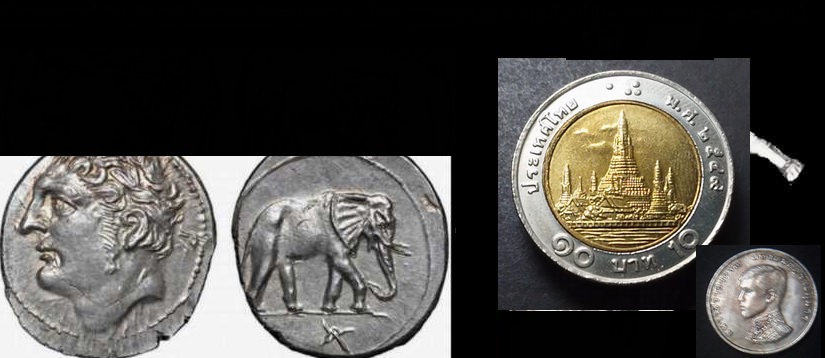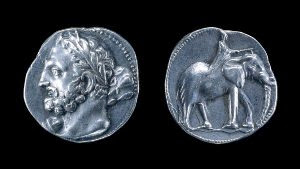The sea narrated by Thon - YouTube:
What is PC shreader? PC shreader is a freeware, it is both for personal and commercial use.
'via Blog this pot of gold found earlier to hanibal coin> 'The true face of Hannibal. This well-preserved coin, circa 208-207 BC, and dated by some at 217 BC., was found in the Chiana (Clanis) valley. This coin was in circulation in the vicinity of Lake Trasimeno and in the Chiana Valley.
What is PC shreader? PC shreader is a freeware, it is both for personal and commercial use.
'via Blog this pot of gold found earlier to hanibal coin> 'The true face of Hannibal. This well-preserved coin, circa 208-207 BC, and dated by some at 217 BC., was found in the Chiana (Clanis) valley. This coin was in circulation in the vicinity of Lake Trasimeno and in the Chiana Valley.
Some
individuals have thrown aside all available evidence and have incoherently
shouted themselves hoarse by claiming that Hannibal who nearly destroyed Rome
belonged to the ‘great White race.’
Whites have
been in North Africa for centuries but they are not indigenous to that area.
They were merely migrants and invaders, not to mention the White slave trade
that brought many Whites to that area. The presence of different races in North
Africa has been mentioned by ancient writers like Diodorus Siculus and
Herodotus. They included Ethiopians or Blacks.
Hannibal has
been variously called a Canaanite or Phoenician. The Canaanites were
descendants of Ham or Hamites. ‘Hamite’ was a term once used widely by
Europeans to denote members of the Black race. ‘Phoenician’ was another term
used to describe these Blacks.
The original
dwelling place of the Phoenicians was not in the Middle East but more likely in
East Africa. According to Herodotus (see The Histories) they lived on the
shores of the Eritrean Sea. This area is widely disputed today, but apparently
it was located on the shores of East Africa.
The ancient
Near East was a melting pot just like modern America. Different races could be
found there, but the original race was a Black one. The Elamites, for instance,
were Blacks. Later on it was possible to find not only Black Phoenicians, but
White and mixed Phoenicians as well.
Carthage on
the North African coast was a Phoenician colony. A reading of history makes it
clear that many migrants including White Greeks settled in that area and
beyond. Thus just like South Africa, it was possible to find different races
there, known as Carthaginians.
The clearest
evidence of Hannibal being Black is the coin found in the Valley of the Clanis
in Italy, not far from where he defeated the Romans at the Battle of Lake
Trasimeno. It is believed to have been minted by Hannibal after the battle. The
date of the coin corresponds to the era of Hannibal’s early battles with the
Romans.
According to
White historians/scholars the coin, representing an elephant on one side and a
Black man on the other, is not Hannibal but a mere elephant driver, never mind
that the various portraits depicting a White Hannibal are those of other
individuals.
The idea
that the Black man was a mere elephant driver is pure rubbish since
Carthaginians often minted coins to portray important personalities or deities.
Moreover the words of Polybius are very telling. According to him before the
Battle of Trasimeno, Hannibal had lost all his elephants with the exception of
one, which he rode.
Thus it is
Hannibal and no one else, portrayed in the ancient coin found in the valley of
the Clanis in Italy. Indeed, a number of such coins exist.
--------------------------------------------------------------------------------
Coinage from
Carthage during Hannibal's time has, from time to time, been speculated to have
Hannibal's portrait upon them. Generally
speaking, the coins at issue are the ones with Tanit/Melquart on the obverse
and a horse on the reverse. archaeologist and documentary maker This Blog
Hannibal
Barca of Carthage, North Africa
Image: Coin
bearing the image of Hannibal and his famed battalion of elephants.
In 247 B.C.,
the year Hannibal Barca was born, the Carthage empire was about 500 years old.
Known as one of the greatest strategist in military history, the battles of
Hannibal would strike a turning point in the history of the continent that
would be called Africa. Carthage had been settled by Phoenicians in North
Africa near the current Tunis. In his 1961 work, French Historian Gabriel
Audisio comments that he considered "Hannibal to be neither a Phoenician,
nor a Carthaginian, nor a Punic, but a North African... The majority of the
Punic populace seems to have had African, indeed Negroid, ancestry."
The
Carthaginians, according to Audisio's research, mixed freely with the native
populations of North Africa. The Punic of North Africa seem to have been a mix
between the Phoenicians and native North Africans, the Berbers. The Phoenicians
were a Semitic people said to have migrated from north of Palestine into
Northern Africa, spreading their dominion throughout the Mediterranean regions.
They were primarily known as merchant traders with an economy tied to the sea
trades.
There is no
picture of Hannibal in existence today. The coin above is frequently presented
by commentators as a representation of Hannibal and his legacy of tamed
elephants. This Blog
This
Blog
Hannibal
Barca of Carthage, North Africa
Image: Coin
bearing the image of Hannibal and his famed battalion of elephants.
In 247 B.C.,
the year Hannibal Barca was born, the Carthage empire was about 500 years old.
Known as one of the greatest strategist in military history, the battles of
Hannibal would strike a turning point in the history of the continent that
would be called Africa.
Carthage had
been settled by Phoenicians in North Africa near the current Tunis. In his 1961
work, French Historian Gabriel Audisio comments that he considered
"Hannibal to be neither a Phoenician, nor a Carthaginian, nor a Punic, but
a North African... The majority of the Punic populace seems to have had
African, indeed Negroid, ancestry."
The
Carthaginians, according to Audisio's research, mixed freely with the native
populations of North Africa. The Punic of North Africa seem to have been a mix
between the Phoenicians and native North Africans, the Berbers. The Phoenicians
were a Semitic people said to have migrated from north of Palestine into
Northern Africa, spreading their dominion throughout the Mediterranean regions.
They were primarily known as merchant traders with an economy tied to the sea
trades.
There is no
picture of Hannibal in existence today. The coin above is frequently presented
by commentators as a representation of Hannibal and his legacy of tamed
elephants. While this writer was not able to find authority that the coins were
made contemporaneously during or near the life of Hannibal -- which was more
than 2,000 years ago -- the existence of such coinage during some point during
our common age is no surprise in light of Hannibal's historical legacy.
What we do have
are descriptions of Hannibal by commentators of his time. According to the
Roman historian Levy of the first century of our era, Hannibal was
"fearless, utterly prudent in danger, indefatigable, able to endure heat
and cold, controlled in eating habits, unpretentious in dress, willing to sleep
wrapped in military cloak, a superb rider and horseman." He was the son of
the Carthage general Hamilcar Barca. There is no knowledge of his mother in the
history records, not even her name. He had two brothers: Hasdrubal resided in
Spain and Maharbal was captain of Hannibal's calvary.



No comments:
Post a Comment